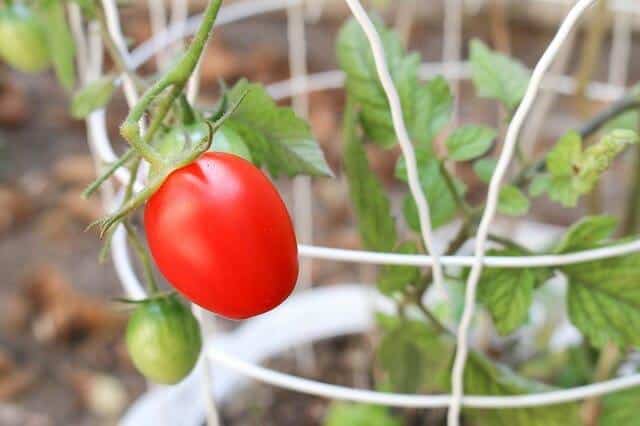I have a confession (one that I’ve made here before): I don’t start seeds indoors. If they can be sown directly, I do that. Most of my garden does get started from seeds. But I buy some seedlings, namely tomatoes and eggplants.
At the garden center, of course I’m drawn to the large and bushy tomato plants, already blooming, maybe even with a few tiny tomatoes growing. If I bring that plant home, I should have ripe tomatoes in about two months (depending on the variety). But those bushes are expensive, and I normally put in 8-10 tomato plants. I simply can’t justify buying the bigger, more expensive bushes when I can also get tomatoes by purchasing the 3-inch-tall seedlings. It’s the same result, after all. It just takes longer.
But, here’s a secret: you can get several small tomato plants off a single large bush. You can propagate tomatoes the same way that you start new house plants — with cuttings. If you do this, you can have multiple tomato plants and still eat your early tomatoes, too. Your mature (“mother”) plant will provide you with tomatoes until your propagated plants start producing.
Rooting only takes about a week. Within seven days, you could have a sturdy, tall tomato seedling, which is about 6-8 weeks faster than starting a plant from a seed.
Benefits to Pruning Large Tomato Plants
If you’re over visiting a friend or neighbor and they have some large tomato plants chugging along, they might allow you to snip a couple of cuttings off their plants. That way, you don’t have to splash out on a mother plant. It should be easy to convince your friend to let you do this. Removing shoots is effectively pruning, and pruning tomato plants is beneficial.
Looking For Non-GMO Vegetable Seeds? Get Them From A Company You Can Trust!
As Louisiana State University’s Ag Center explains, pruning off the bottom branches encourages fruit production at the top of the plant. This way, heavy fruit on the bottom branches won’t pull those branches down so that the tomatoes rest on the soil, which can cause them to rot. Removing branches also improves air circulation, which can help with insect and disease control. Wet leaves can lead to problems like late blight. By pruning branches, the remaining leaves will receive more sun and air, and will dry faster.
Preparing Your Cuttings

Typically, we root houseplants by placing them in water until roots form. Tomato cuttings can be started the same way. However, they will develop a stronger root system more quickly if they are rooted directly in soil.
Start by snipping off a side shoot (branch) that is at least 6-8 inches long. Be careful that you don’t lop off the top of the main stem by mistake. Once the shoot is removed, trim the bottom leaves off, so that there are only two leaves left at the top. If there are any flowers or buds on the branch, trim those off, too.
If you are rooting the shoots in water, immediately set them in a glass or jar of water. Make sure you don’t submerge the top leaves. Set the jar in a warm place, and top off the water as needed, if any evaporates. In about one week, roots will form. At that point, you can plant the shoots.
How to Plant the Shoot in Soil
If you are rooting the shoots in soil (or soilless mix), have your pots prepared before you snip the shoots off the mother plant. You should use clean pots, filled with damp soil. You can use a pencil or other instrument of that size (like a dowel or wooden spoon handle) to create a hole that the shoot can be quickly popped into.
The All-Natural Fertilizer That Can Double Your Garden Yield!
Bury the stem of the shoot up to where you snipped off the bottom leaves. For about a week, keep the potted shoots in a warm and sunny (but not hot) location. Also, make sure to keep the soil or mix damp at all times, to keep the shoot alive and help the roots form.
If your mother plant came from a garden center or greenhouse and needs to be hardened off, then you should harden off the cuttings, as well. If your mother plant had already been hardened off, then it’s safe to treat your cuttings as being hardened off, too. And, in that case, it’s also possible to root your cuttings directly into your garden. Just take extra care to protect them from the sun if it gets too hot and to make sure they get sufficient water.
Starting tomato plants with cuttings is a lot faster than growing tomatoes from seed. It’s also a cost-effective way to get a number of plants from one larger plant. Additionally, it’s a way to grow tomatoes year-round, on a serious budget. If you root cuttings into pots in late summer, and keep those pots indoors, you will have producing tomato plants over the winter. Those indoor plants, in turn, can provide cuttings for new plants in the spring. In this way, you can keep cloning your favorite tomato plant for several growing seasons, for free.










